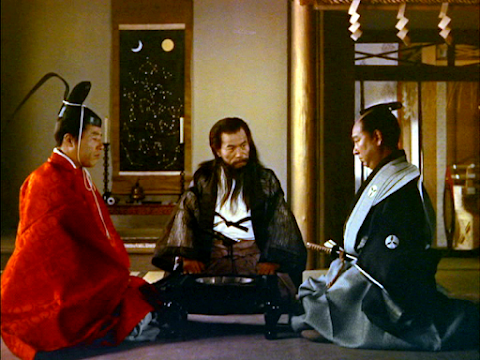Obscure Japanese Film #87
 |
| Ayako Wakao |
1858. Princess Kazu no Miya (Ayako Wakao), the sister of the Emperor, has been engaged to Prince Arisugawa (Raizo Ichikawa) since childhood. Her maid, Yuhide (Fujiko Yamamoto), is more like a best friend than a servant, and it’s assumed that she will become the Prince’s concubine if the Princess fails to produce a male heir. Although the two women seem to have little problem with this, the Prince disagrees with the practice. However, it turns out to be irrelevant as their plans go awry in the wake of the signing of the Treaty of Amity and Commerce with the United States. As this action was undertaken by the Tokugawa Shogunate without the Emperor’s blessing, relations between the Shogunate and the Imperial Palace take a turn for the worse.
Yuhide’s father, Tomofusa (Eijiro Tono), spots an opportunity to improve his own position by putting forward a scheme to politician Tomomi Iwakura (Eitaro Ozawa) and daimyo Tadaaki Sakai (Masao Mishima) to arrange a marriage between the Princess and the new shogun, Iemochi Tokugawa (Yoichi Funaki), in order to cement ties between the shogunate and the palace. The Princess finds herself under pressure to break her engagement; aided by Yuhide, she attempts to flee, but this is anticipated by Tomofusa and the plan fails. Meanwhile, Yuhide is dealing with her own feelings for the Prince as well as suspicions about her own parentage when Tomofusa puts her life in danger but she is protected by a mysterious wandering monk (Eijiro Yanagai)…
Produced at their Kyoto studios, this Daiei production was based on a 1953 novel entitled Kojo Kazu no Miya (literally ‘Imperial Princess Kazu of the Palace’) by Matsutaro Kawaguchi (father of actor Hiroshi Kawaguchi), who also happened to be head of production at Daiei. Although most of the characters are real historical figures, Yuhide, Tomofusa and the monk seem to be fictional inventions. The real Princess Kazu no Miya (1846-77) was only 12 in 1858, when this story begins, although that’s not apparent here, nor is the fact that the real events covered took place over a period of nearly 20 years.
Ayako Wakao is associated with contemporary roles to such an extent that it seems a little strange to see her in period costume, although it’s by no means the only occasion she appeared in a historical drama. This must also be the wimpiest role she ever played; as portrayed in Suzakumon, Kazu no Miya is a fragile and tragic victim of events, rather than a protagonist who instigates any of the action. Wakao is fine as always, but it’s hard to believe this is the same actress who played the tough prostitute out for revenge in Irezumi (1966).
Director Kazuo Mori (1911-89) was a competent but not especially distinguished filmmaker who had worked as an assistant to Daisuke Ito and later directed episodes in the Shinobi no mono and Zatoichi series as well as the previously-reviewed The Saga of Tanegashima, also featuring Ayako Wakao (in fact, he directed Wakao nine times). I found Ichiro Saito’s score quite beautiful and atmospheric at first, but unfortunately it is overused here and becomes repetitive and sometimes cloying. It’s visually that this film stands out the most, and it’s no surprise that the colour cinematography by Kazuo Miyagawa (a favourite of Mizoguchi and Kurosawa) won a couple of awards, although I thought that the colour timing in the copy I saw could be improved.

L-R: Eitaro Ozawa, Eijiro Tono and Masao Mishima
Suzakumon probably seemed quite old-fashioned and sentimental even in 1957 (the year of Masaki Kobayashi’s Black River and Yasuzo Masumura’s debut, Kisses) and there’s little in the way of action. However, it has enough good qualities to make it worth seeing for fans of Japanese period dramas, including alongside its star trio a strong supporting cast featuring Eijiro Tono, Eitaro Ozawa and Masao Mishima, three stalwarts from Haiyuza, the theatre company and acting school which also produced Tatsuya Nakadai; Tono has the juiciest role of the three here and certainly makes the most of it.
Note on the title:
It’s unclear why the title of the novel was not used but, according to Wikipedia, “The Suzakumon was the main gate built in the center of the south end of the imperial palaces in the Japanese ancient capitals of Fujiwara-kyō, Heijō-kyō, and later Heian-kyō. The placement followed the ancient Chinese palace model requirements at the time, where Suzaku, the Vermilion Bird was the Guardian of the South. It was said to be the site where foreign dignitaries were received by the Emperor.”





No comments:
Post a Comment